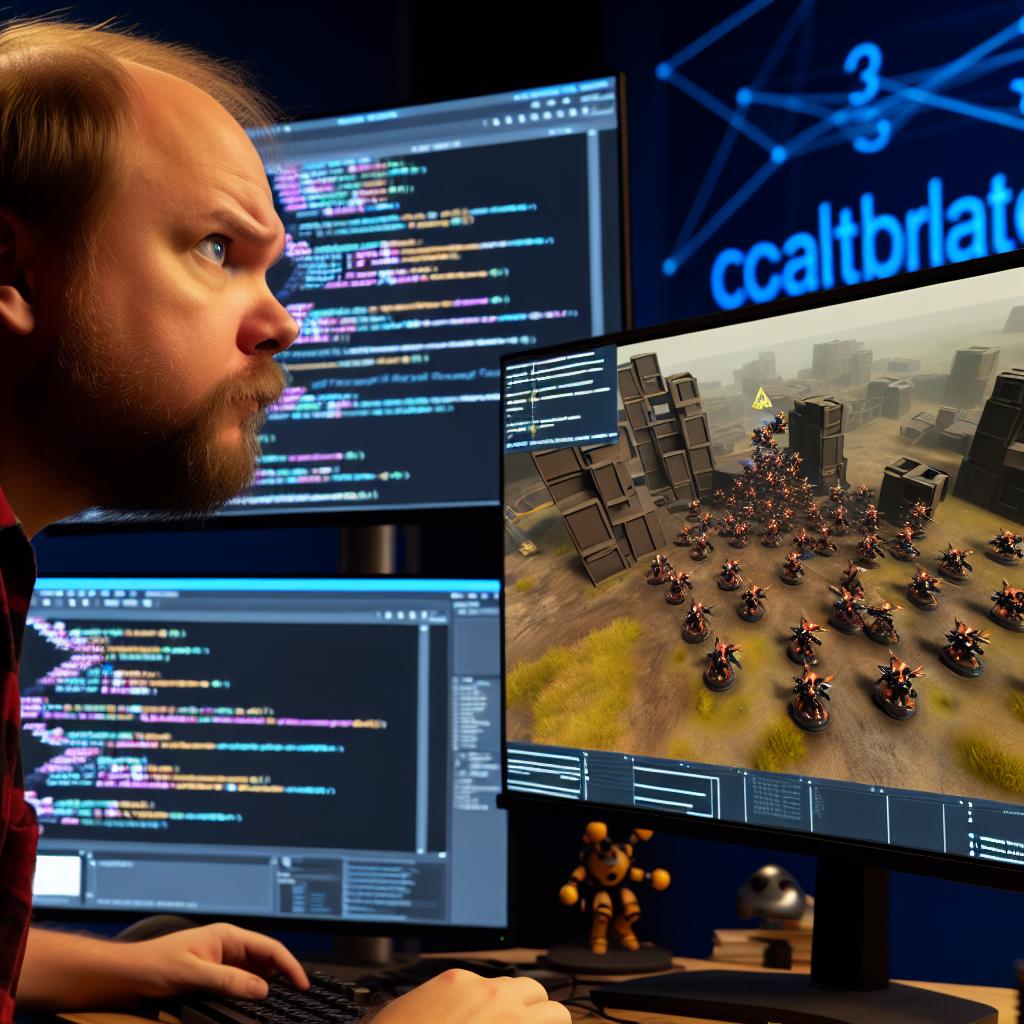Introduction:
In today’s gaming landscape, multiplayer features are essential for engaging players.
Integrating multiplayer elements can create dynamic and competitive experiences.
Multiplayer features allow players to connect with friends and strangers, fostering a sense of community.
It enhances replayability and extends the lifespan of games.
Moreover, multiplayer features add a social aspect to gaming, enabling players to collaborate and compete in real-time.
Integrating multiplayer features in games is crucial for creating immersive and interactive experiences for modern gamers.
Understanding the different types of multiplayer features:
When it comes to integrating multiplayer features in games, developers have a variety of options to consider.
Understanding the different types of multiplayer features available can help game creators make informed decisions about which features to implement in their games.
Online Co-op:
Online co-op is a multiplayer feature that allows players to team up and play together over the internet.
This type of multiplayer feature fosters collaboration and teamwork among players, as they work together to achieve common goals in the game.
The benefits of online co-op include enhanced social interaction, increased replay value, and the ability to tackle challenges as a group.
However, drawbacks of online co-op can include issues with connectivity, potential for griefing or trolling behavior, and reliance on other players to progress in the game.
Competitive Multiplayer:
Competitive multiplayer is a multiplayer feature that pits players against each other in head-to-head competition.
This type of multiplayer feature appeals to players who enjoy testing their skills and abilities against others, as well as those who thrive on the excitement of competition.
The benefits of competitive multiplayer include the thrill of victory, the opportunity to improve one’s skills through practice and experience, and the potential for intense, adrenaline-pumping gameplay.
However, drawbacks of competitive multiplayer can include increased levels of stress and pressure, the presence of toxic or unsportsmanlike behavior, and the risk of encountering highly skilled or overpowered opponents.
Local Multiplayer:
Local multiplayer is a multiplayer feature that allows players to compete or cooperate with one another in the same physical location, typically using a split-screen or shared-screen format.
This type of multiplayer feature is perfect for players who prefer face-to-face interactions and enjoy the camaraderie of playing games together in person.
The benefits of local multiplayer include the opportunity for social bonding, the ability to share the gaming experience with friends and family, and the convenience of playing together without the need for an internet connection.
However, drawbacks of local multiplayer can include limited screen space for each player, potential for distraction or interference from other players, and a lack of online connectivity options for players who are not physically present.
Transform Your Career Today
Unlock a personalized career strategy that drives real results. Get tailored advice and a roadmap designed just for you.
Start NowThe different types of multiplayer features each have their own unique advantages and challenges.
By understanding the benefits and drawbacks of online co-op, competitive multiplayer, and local multiplayer, game developers can make informed decisions about which features to incorporate into their games to enhance the overall player experience.
When integrating multiplayer features in your game, it is essential to carefully select the right features to enhance the overall gaming experience for players.
Here are some key considerations to keep in mind:
Consider the genre and target audience of your game:
- Understand the type of game you are developing and the players you are targeting.
- Choose multiplayer features that align with the genre of your game to ensure relevance.
- For example, a fast-paced action game may benefit from real-time multiplayer features.
- On the other hand, a strategy game may be better suited for turn-based multiplayer gameplay.
- Customize the multiplayer experience based on the preferences and expectations of your target audience.
Determine whether real-time or turn-based multiplayer would be more suitable for your game:
- Real-time multiplayer involves players competing or collaborating in the game simultaneously.
- This type of multiplayer feature requires quick reflexes and immediate decision-making.
- Turn-based multiplayer, on the other hand, allows players to take turns making moves.
- This can be ideal for strategy games or games that require more thoughtful decision-making.
- Consider the pace and dynamics of your game when choosing between real-time and turn-based multiplayer.
By carefully selecting the right multiplayer features that match your game’s genre and target audience, you can create an engaging and immersive gaming experience that keeps players coming back for more.
Uncover the Details: Challenges Faced by IT Governance Managers Today
Designing Gameplay Mechanics Around Multiplayer Features
Multiplayer features can impact level design by requiring larger and more dynamic environments.
Combat mechanics may need to be adjusted to accommodate multiple players, such as incorporating team-based strategies.
Progression systems can offer rewards for cooperative play to encourage teamwork and collaboration.
Importance of Balancing Gameplay for Both Single-Player and Multiplayer Modes
Single-player experiences should remain engaging and challenging without compromising multiplayer balance.
Multiplayer modes must be fair and enjoyable for all players, regardless of skill level or experience.
Balancing gameplay ensures a satisfying experience for both solo and multiplayer gamers.
Uncover the Details: Data Governance Strategies for Data Warehouse Architects
Implementing networking infrastructure for multiplayer functionality:
When it comes to integrating multiplayer features in games, one of the key components is establishing a solid networking infrastructure.
This is crucial for ensuring smooth gameplay experiences for players across different locations.
In this section, we will delve into the basics of networking in game development, including the client-server architecture and peer-to-peer networking.
Additionally, we will provide some valuable tips for optimizing network performance and reducing lag in multiplayer games.
Basics of networking in game development:
- Client-server architecture:
- In a client-server architecture, one player acts as the server while others connect as clients. This setup allows for centralized control and coordination of game data.
- Peer-to-peer networking:
- Peer-to-peer networking involves direct communication between players without the need for a central server. This can be useful for reducing latency and dependency on a single point of failure.
Tips for optimizing network performance and reducing lag:
- Use authoritative servers:
- Authoritative servers help prevent cheating by validating player actions and game states. This ensures a fair playing field for all participants.
- Implement network prediction:
- Network prediction techniques can help compensate for latency issues by anticipating player movements. This can improve the overall responsiveness of the game.
- Optimize data transmission:
- Minimize the amount of data sent over the network by using efficient protocols and compressing information when possible. This can help reduce bandwidth usage and improve performance.
- Monitor and analyze network traffic:
- Regularly monitor network traffic to identify bottlenecks or latency spikes. Analyzing this data can help pinpoint areas for optimization and provide insights into player behavior.
- Implement lag compensation:
- Lag compensation techniques can help mitigate the effects of network latency on gameplay. By synchronizing game states and actions, players can experience smoother interactions in real-time.
By focusing on these networking fundamentals and optimization strategies, game developers can create a seamless multiplayer experience that keeps players engaged and satisfied.
Remember that networking is a critical aspect of multiplayer game development, so investing time and resources into building a robust infrastructure is key to success.
Gain More Insights: Essential Tools for IT Procurement Specialists
Transform Your Career Today
Unlock a personalized career strategy that drives real results. Get tailored advice and a roadmap designed just for you.
Start NowTesting and refining multiplayer features:
Playtesting multiplayer features is a crucial step in the game development process.
It allows developers to gather valuable feedback from real players who can provide insights on how to enhance the gaming experience.
By involving a focus group or beta testers, developers can identify potential issues before the game is released to the public.
During playtesting, it is essential to design scenarios that test the multiplayer features extensively.
This includes stress-testing the servers to ensure they can handle the expected player load without crashing or lagging.
By simulating different gameplay situations, developers can evaluate the stability and performance of the multiplayer functionality.
Collecting feedback from playtesters is key to refining multiplayer features.
Developers should encourage testers to provide detailed comments on their experience, highlighting what they enjoyed and what they found challenging.
This feedback can help pinpoint areas for improvement and guide developers in making necessary adjustments.
In addition to feedback, developers should also collect data on gameplay metrics to analyze player behavior.
This includes tracking metrics such as player engagement, retention rates, and in-game purchases.
By understanding how players interact with the multiplayer features, developers can make informed decisions on how to optimize the gaming experience.
Addressing bugs and issues identified during playtesting is essential to ensuring a smooth multiplayer experience.
Developers should prioritize fixing any technical glitches or gameplay imbalances that may disrupt the overall gameplay.
By conducting thorough testing and iterations, developers can refine the multiplayer features to meet player expectations.
It is crucial to involve the community in the testing process by engaging with players through forums, social media, or in-game surveys.
This direct interaction allows developers to gather feedback from a wider player base and identify common issues or suggestions for improvement.
By fostering a collaborative relationship with the player community, developers can create a more engaging and enjoyable multiplayer experience.
Overall, testing and refining multiplayer features require a systematic approach that combines feedback, data analysis, and iterative development.
By investing time and resources into playtesting and addressing player feedback, developers can create multiplayer features that enhance the overall gaming experience and attract a loyal player base.
Transform Your Career Today
Unlock a personalized career strategy that drives real results. Get tailored advice and a roadmap designed just for you.
Start NowFind Out More: How Virtualization Engineers Improve System Resilience

Incorporating social features and community building:
Explore how social features like chat, leaderboards, and matchmaking can enhance the multiplayer experience.
Discuss the benefits of fostering a strong community around your game through multiplayer events and player interactions.
Social features play a crucial role in enhancing the multiplayer experience of a game.
By integrating features like chat, leaderboards, and matchmaking, developers can create a more engaging and immersive gaming environment for players.
Benefits of Social Features:
Improved Communication: Chat functionality allows players to communicate with each other in real-time, fostering teamwork and coordination.
Competition: Leaderboards provide a sense of competition among players, motivating them to improve their skills and rankings.
Matchmaking: Matchmaking algorithms ensure fair and balanced matches, creating a more enjoyable experience for all players involved.
Community Building:
Building a strong community around your game is essential for its long-term success.
Multiplayer events and player interactions are key components in fostering a community of dedicated players who are invested in the game.
How to Build a Community:
Organize Events: Regular multiplayer events, such as tournaments or in-game challenges, can bring players together and create a sense of camaraderie.
Encourage Player Interactions: Providing opportunities for players to interact, whether through chat, forums, or in-game activities, can help build relationships and strengthen the community.
Listen to Feedback: Actively engaging with your player community, listening to their feedback, and implementing their suggestions can help foster a sense of ownership and belonging among players.
By incorporating social features and focusing on community building, developers can create multiplayer games that not only provide an enjoyable gaming experience but also cultivate a loyal and engaged player base.
Monetizing Multiplayer Features
Monetizing multiplayer features in games is a crucial aspect that game developers need to carefully consider.
By integrating monetization strategies effectively, developers can ensure the sustainability of their multiplayer games while also providing value to players.
In this section, we will explore various monetization strategies for multiplayer games and delve into the ethical considerations associated with implementing microtransactions.
Analyze Different Monetization Strategies
One of the most common monetization strategies for multiplayer games is selling cosmetic items.
These items do not affect gameplay but allow players to customize their characters or avatars, enhancing their gaming experience.
By offering a variety of cosmetic items, developers can appeal to players’ preferences and encourage them to make purchases.
Transform Your Career Today
Unlock a personalized career strategy that drives real results. Get tailored advice and a roadmap designed just for you.
Start NowCosmetic items are often sold through in-game stores or marketplaces, where players can use virtual currency or real money to buy them.
Another popular monetization strategy is the use of loot boxes.
Loot boxes are virtual crates or chests that contain random items or rewards, which players can purchase with in-game currency or real money.
The element of chance in acquiring rare or exclusive items adds excitement to the game and motivates players to spend money.
However, loot boxes have faced controversy due to concerns about gambling-like mechanics and their potential to exploit players, especially minors.
Developers need to implement transparent and fair systems for loot box mechanics to maintain player trust and avoid negative feedback.
Expansion packs are also a common monetization strategy for multiplayer games.
These packs are additional content or updates that introduce new features, levels, missions, or storylines to the game.
By purchasing expansion packs, players can access fresh content and extend their gameplay experience.
It is essential for developers to communicate the value of expansion packs to players and ensure that they deliver substantial new content to justify the purchase.
Players should feel that expansion packs enhance their gaming experience and provide meaningful gameplay additions.
Ethical Considerations of Implementing Microtransactions
While monetization is essential for the sustainability of multiplayer games, developers need to consider the ethical implications of implementing microtransactions.
Microtransactions, especially in the form of loot boxes or in-game purchases, have raised concerns about potential harm to players.
This includes issues like addiction, overspending, or unfair advantages for paying players.
Developers must prioritize player well-being and ensure that monetization strategies do not compromise the integrity of the game or exploit players.
Transparency, fairness, and player autonomy are key principles that developers should uphold when designing microtransaction systems.
Moreover, the issue of underage spending is a significant ethical consideration in multiplayer games.
Younger players may not have a full understanding of the financial implications of in-game purchases and could overspend without parental consent.
Developers need to implement age-appropriate controls, such as parental locks or spending limits, to protect vulnerable players and promote responsible gaming practices.
By fostering a safe and ethical environment for players, developers can build trust and credibility with their gaming community.
Transform Your Career Today
Unlock a personalized career strategy that drives real results. Get tailored advice and a roadmap designed just for you.
Start NowIntegrating multiplayer features in games involves careful consideration of monetization strategies and ethical considerations.
By analyzing different monetization approaches like selling cosmetic items, loot boxes, or expansion packs, developers can strike a balance between revenue generation and player engagement.
Furthermore, addressing ethical concerns related to microtransactions is crucial to ensure that players are treated fairly and their well-being is prioritized.
With thoughtful planning and a player-centric approach, developers can create successful multiplayer games that offer value to players and encourage long-term engagement.
Enhancing Player Engagement Through Multiplayer Features
Integrating multiplayer features in games can enhance player engagement.
These features create unique gaming experiences for players.
By understanding the target audience, developers can design scalable solutions.
Additionally, optimizing network performance elevates multiplayer games.
Collaboration with other developers is essential for success.
Testing the features extensively improves gameplay quality.
Listening to player feedback ensures ongoing improvement.
Experimentation with different multiplayer modes attracts diverse players.
Social integration and community building lead to innovative experiences.
As the gaming industry evolves, developers should push boundaries.
Creating unforgettable multiplayer experiences must be a priority.
Additional Resources
Black Ops 6 and Call of Duty: Warzone Season 01 … – Call of Duty




